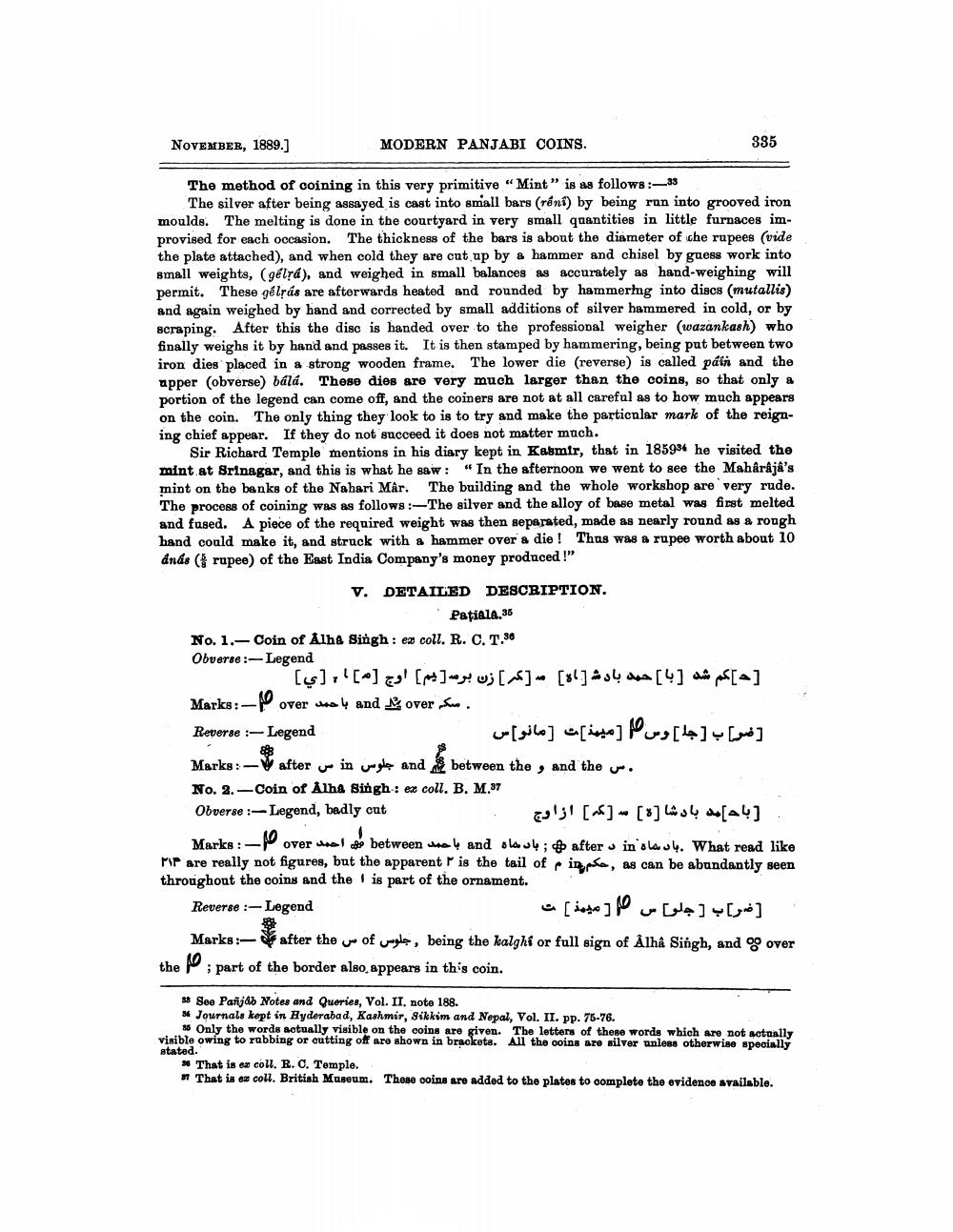________________
NOVEMBER, 1889.)
MODERN PANJABI COINS.
335
The method of coining in this very primitive "Mint" is as follows:-33
The silver after being assayed is cast into small bars (réni) by being run into grooved iron moulds. The melting is done in the courtyard in very small quantities in little furnaces improvised for each occasion. The thickness of the bars is about the diameter of che rupees (vide the plate attached), and when cold they are cut up by & hammer and chisel by guess work into small weights, (gélrd), and weighed in small balances as accurately as hand-weighing will permit. These gélrás are afterwards heated and rounded by hammering into discs (mutallis) and again weighed by hand and corrected by small additions of silver hammered in cold, or by scraping. After this the disc is handed over to the professional weigher (wazankash) who finally weighs it by hand and passes it. It is then stamped by hammering, being put between two iron dies placed in a strong wooden frame. The lower die (reverse) is called páin and the apper (obverse) bálá. These dies are very much larger than the coins, so that only a portion of the legend can come off, and the coiners are not at all careful as to how much appears on the coin. The only thing they look to is to try and make the particular mark of the reigning chief appear. If they do not succeed it does not matter much.
Sir Richard Temple mentions in his diary kept in Kasmir, that in 185934 he visited the mint at Srinagar, and this is what he saw: "In the afternoon we went to see the Maharaja's mint on the banks of the Nahari Mar. The building and the whole workshop are very rude. The process of coining was as follows:-The silver and the alloy of base metal was first melted and fused. A piece of the required weight was then separated, made as nearly round as a rough hand could make it, and struck with a hammer over a die! Thus was a rupee worth about 10 dnds (# rupee) of the East India Company's money produced !"
V. DETAILED DESCRIPTION.
Patial4.36 No. 1.- Coin of Alha Singh: ex coll. R. C. T.56 Obverse :-Legend
[us].'[^] [?] – W; [S] - [81] 4 [4] [-] Marks :- over wall and Mover Sw. Reverse :- Legend
میمنت [مانوس
ضرب [ جلوس
Marks: - after u in uwgle and between the , and the un. No. 2.-Coin of Alha Singh: ex coll. B. M.37 Obverse :-Legend, badly cut
ulj! [-] - [8] 64 [24].
Marks :-
over
What read like .باد بماء in د after ھ ز باد ماه and باحمد between ھے احمد
MP are really not figures, but the apparent is the tail of pin, pse, as can be abundantly seen throughout the coins and the 1 is part of the ornament. Reverse :- Legend
[inde] l w [dbo] [30] Marks :- after the ww of woglo, being the kalghi or full sign of Ålha Singh, and 99 over the part of the border also appears in this coin.
» Soe Parijab Notes and Queries, Vol. II. note 188.
Journals kept in Hyderabad, Kashmir, Sikkim and Nepal, Vol. II. pp. 75-76.
16 Only the words actually visible on the coins are given. The letters of these words which are not actually visible owing to rubbing or cutting off are shown in brackets. All the coins are silver unless otherwise specially atated. * That is ex coll. R. C. Temple.
That is a coll. British Museum. These coins are added to the plates to complete the evidence available.




